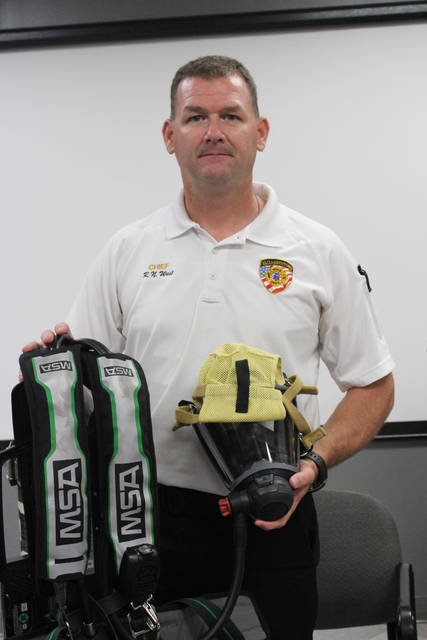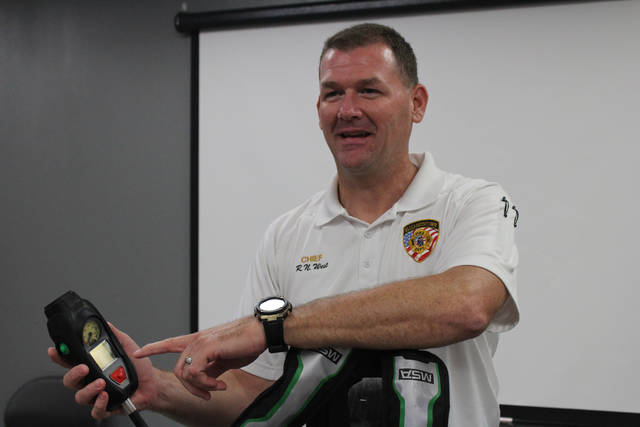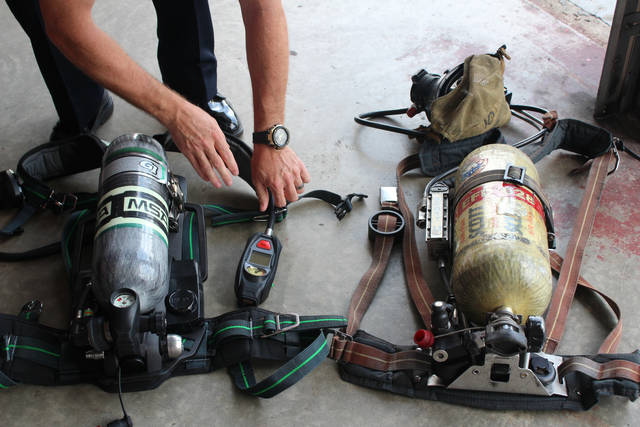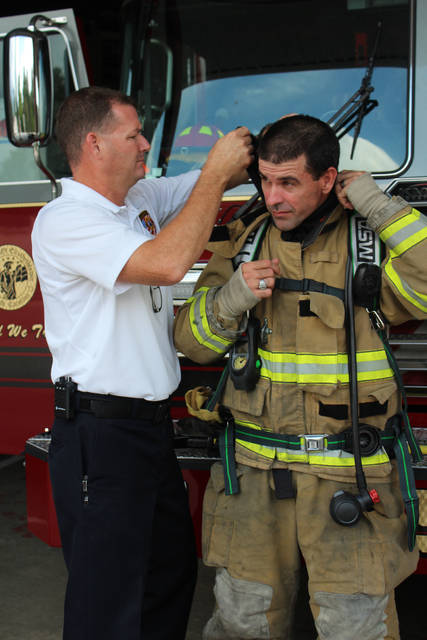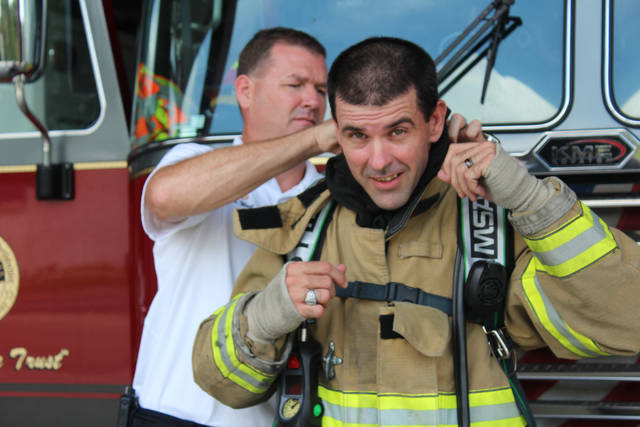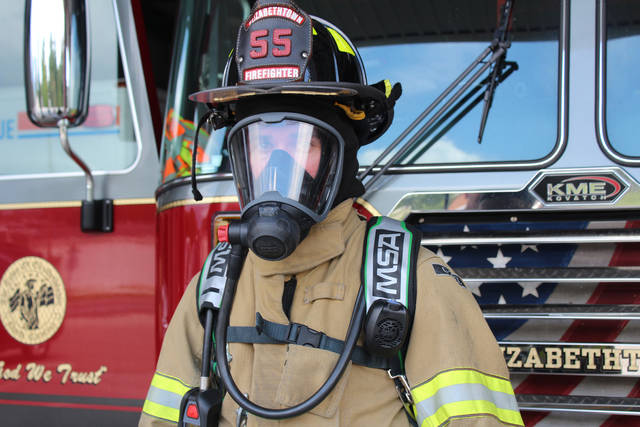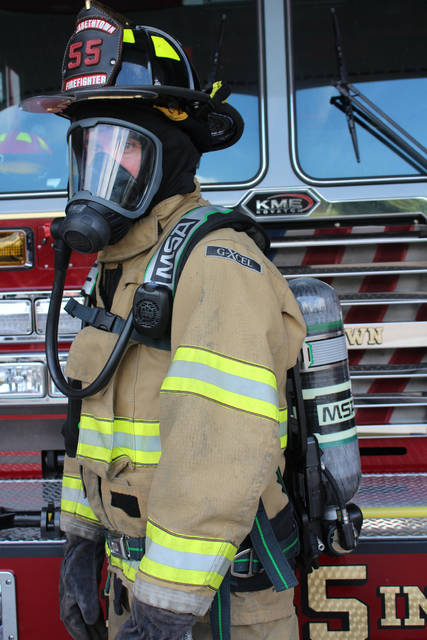ELIZABETHTOWN — The Elizabethtown Fire Department can breathe more easily thanks to FEMA.
The department recently received word that it is the recipient of FEMA’s Assistance to Firefighters Grant, money earmarked for the firefighting and emergency response needs of fire departments and non-affiliated emergency medical service organizations.
According to Elizabethtown Fire Department Chief Nick West, the department will be receiving $168,000 to be used for purchasing new air packs — the backback units and face masks carried by firefighters that provide fresh air and protection against airborne pollutants.
“We’re very grateful to be receiving this money, and it will go a long way toward meeting our needs,” West commented.
FEMA has allocated $6,300 for 27 units, and the fire department must provide a 5-percent match, standard for all Assistance to Firefighters grants. The new MSA air packs will replace 15-year-old model currently in use by department members.
“The air packs themselves must be re-certified every three years, and the re-certification can only be done five times, so we’ve reached the life expectancy, if you will, of our current air packs,” West explained, adding that without the grant, a roughly $170,000 expense would be difficult for the organization.
According to the chief, the new units are “as good as you can get.” The canister that holds the air is smaller than the current model but holds the same amount of air. The result is that the air is more pressurized — 4,500 psi compared to the older 2,200 psi — but the canister itself is lighter and has what West called a “lower profile.”
“The lower the profile, the less chance of us snagging the unit on something,” he explained, pointing out the smooth lines and rounded corners on the unit as a whole. “Everything is very clean and the hardware minimal to reduce the chance of snags.”
The biggest changes to the unit are technological. All air packs have a pass device, a handheld unit designed for safety that attaches to the backpack the way a pocket watch hangs from a vest. The upgraded pass unit has, in addition to an analogue gauge, a digital screen that shows the amount of remaining oxygen. In keeping with revised standards, a warning sound unique to the firefighting industry sounds when the level in the tank is reduced to 35 percent. The piercing sound can only be turned off by replacing the air tank or turning the unit off. In case ambient noise prohibits hearing the alarm, or to prevent one firefighter from mistaking the alarm for his buddy’s unit, lights inside the face mask also alert the wearer the tank is approaching critical levels.
According to West, the tank should last the wearer around 30 minutes.
“We considered going to something higher, but ultimately, we want safety,” he explained. “With a 30-minute tank, they’re in for maybe 20 minutes before the alarm will sound, then they come out for a drink of water and to cool down while their tank is being replaced, then back in for the duration of the second tank, then back out for full rehab. That’s as long as we would want anyone to be engaged in a structure fire.”
The pass device also serves other purposes. Infrared technology and heat sensors project an image onto the digital screen so users can see in the dark. The unit is so sensitive to heat that, when West put his hand on the plastic table, removed it, and aimed the sensor at the spot, an infrared image of his hand remained on the screen.
The safety features don’t just alert the wearer, but other firefighters, to danger. The unit has a sensor that is able to determine if it’s in one position for too long. After remaining immobile for a certain length of time, the alarm will sound.
“It lets us know that we would need to go check on somebody because they may be trapped or disoriented,” West offered.
The face mask got updates as well. The new unit protects wearers not only from heat and smoke, but also from dangers like radioactivity and chemicals. A voice amplifier allows wearers to converse, but also eliminates breathing noises. Unlike the former units that required users to thread a hose from the air tank to the mask, the new face mask simply snaps into the hose.
The unit comes with a 15-year warranty, the length of time the department is allowed to use it anyway.
West pointed out many features of the new packs, but one he seemed particularly excited about involved other fire departments.
“Bladenboro just got these same air packs, so us having them will really increase interoperability,” he suggested. “Not only will we all be using the same air bottles and be able to trade those out, but we’ll all be trained on the same units.”
“This feature here,” he continued, pointing to a stem, “allows another firefighter to hook up his air tank to your backpack and give you air. The fact that departments are using the same air pack means we can do that for each other.”
The department has formally accepted the grant. West said he has been told by the dealer the units should arrive in September, after which time firefighters will undergo fit training involving utilizing computers to tailor each pack to an individual firefighter. After subsequently being trained on usage, members can begin using the new units.
Chrysta Carroll can be reached by calling 910-862-4163 or emailing ccarroll@s24515.p831.sites.pressdns.com.
